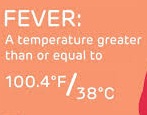Today I am going to talk about the classification,
types, and patterns of fever! Fever is defined as the elevation of an individual's
core body temperature above a set point that is normally regulated by the
body's thermoregulatory center in the hypothalamus, this increase in the body's
set point temperature is often secondary to a pathological process that
involves the release of immunological mediators to trigger the thermoregulatory
center of the hypothalamus to elevate the body's core temperature. The normal
temperature of the human body is considered to be 37degrees of Celsius and
varies by about 0.5 degrees of Celsius, through the course of the day this
minor variation of the core temperature is the result of many normal
physiological processes of the human body including sleep-wake cycles,
metabolic changes, hormone variability, and activity levels.
In fever the increase in the core
body temperature is often greater than 0.5degrees of Celsius and attributed to
a fever-inducing substance which is called pyrogen, it is important to
distinguish that the definition of fever is not synonymous with the definition
of hyperthermia, in fever there is an increase in the set point temperature brought
about by the hypothalamus which enables the body to maintain a controlled
increase of the core temperature and general functionality of all organ systems
in hyperthermia however the increase of the body's core temperature is beyond the
confines of the set point temperature and regulation of the hypothalamus based
on duration.
Fevers can be classified into acute, sub-acute, and chronic fevers. Acute fevers which are less than seven days in duration are characteristics of infectious diseases such as malaria and viral upper respiratory tract infection. Subacute fevers which are usually not more than two weeks in duration may be seen in cases of typhoid fever and intra-abdominal abscesses. Chronic or persistent fevers which are more than two weeks in duration are typical of chronic bacterial infections such as tuberculosis, viral infections like HIV, cancers, and connective tissue diseases however any cause of acute fever can become persistent or chronic if untreated based on the height of body temperature.
Fever can also be classified into
low grade, moderate grade high grade, and hyperpyrexia, this chart shows
body temperature ranges of different grades of fever for example if the body
temperature is between 40.1 and 41.1 degrees of Celsius, it will be called a
high-grade fever. There are five clinical patterns of fever; they are intermittent,
remittance, hectic, continuous or sustained, and relapsing. Intermittent fever
is defined as a fever present only for several hours during the day, so the temperature
is elevated but falls to normal each day, this pattern of fever can be seen in malaria
pyogenic infections, tuberculosis, Schistosomiasis, lymphomas, leptospira,
borrelia kalazar, and septicemia. Remittance fever is defined as a fever in
which the temperature falls each day but is not normal, such fevers are often
associated with infectious diseases such as infective endocarditis, rickettsia
infections, and brucellosis either intermittent or limiting fever can be called
hectic when the difference between peak and trough temperature is great which
is 1.4 degrees of Celsius or more here trough temperature indicates the relatively
lower temperature. This pattern is thought to be very suggestive of an abscess
or pyogenic infection such as pyelonephritis and ascending cholangitis, but may
also be seen with tuberculosis, kidney cancers, lymphomas and drug reactions or
sustained fever is a pattern in which there is little change in the elevated temperature
during a 24hour period. These fevers are characteristics of lower and gram-negative
pneumonia, typhoid acute bacterial meningitis, urinary tract infection, etc.
Relapsing fever is a variant of the intermittent
pattern where fever spikes are separated by days or weeks of intervening normal
temperature such fevers may be seen in red bite fever, malaria, cholangitis,
Hodgkin's disease, and other neoplasms. Now let's talk about the significance
of these fever patterns in clinical practice typical fever patterns are rarely observed
this is as a result of several confounding factors such as ingestion of
antipyretics partial treatment with antimicrobials and a typical presentation
in the elderly immunocompromised and severely malnourished individuals, however
when observed typical fever patterns may provide some useful diagnostic clues
for infectious diseases without localizing signs, such as malaria and typhoid
they may also prove useful in eliminating unlikely diagnosis.
In poor research settings analysis
of fever, patterns may provide diagnostic clues for difficult to diagnose infectious
diseases especially when appropriate diagnostic investigations are unavailable
or unhelpful in the evaluation of piracy of unknown origin, for instance, the
presence of low-grade intermittent fever and night sweats without localizing
sign is a useful clue to investigate for extra-pulmonary tuberculosis or to initiate
empirical anti-tuberculosis therapy in tuberculosis endemic regions.
Thank you


